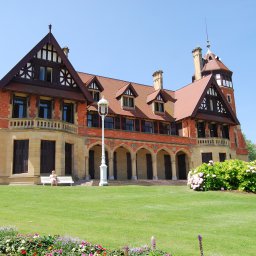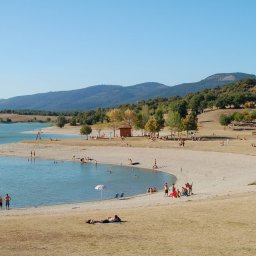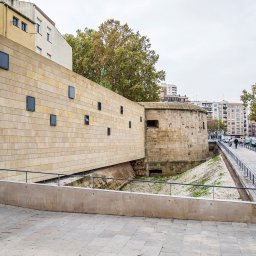The Northern Way, which passes through the Basque Country, was the preferred route of the European nobility during the Middle Ages as it was deemed safer for travelling. This millennial pilgrim path is waymarked all the way to Compostela with the iconic scallop shell signs. The Camino hugs the coastline in Gipuzkoa and heads inland in Bizkaia before reaching Cantabria.
Following a ten-year refurbishment, the Pórtico de la Gloria, resplendent in its newly restored colours, is another good reason to take on the Camino.
Generally speaking, people’s reasons for doing the Camino are similar: they are looking for a personal challenge, addressing an inner struggle, wanting to share the experience, or contemplating man’s role in the greater scheme of things.
The Camino has existed for centuries. Possibly since the first Europeans set out to follow the sunset, a route that invariably led them to the place the Romans called Finis Terrae, in Galicia. Other similarly-named landmarks can be found elsewhere in the world today.
The rest is history. The apparition of Saint James in Iria Flavia, the cathedral, and the jubilee came later and consolidated it as a pilgrim route. Nowadays, the French Way, which crosses the border at Roncesvalles in the Pyrenees, and goes through Navarre, La Rioja, Burgos, and Palencia, entering Galicia via Leon, is the most popular route today. Some believe, however, that the Northern Way, which crosses the border at the Bidasoa River, is an older, more primitive route. There is a path from Irun to Logroño/Navarrete which connects the two Caminos and several other connecting branches along the way.
The Camino in Gipuzkoa
The first stage of the Coastal Route starts at the Santiago Bridge across the River Bidasoa in Irun. Running close the sea, the path works its way through the hills of Jaizkibel and Ulia. Accompanied by the salty sea air, walkers pass through pretty towns (e.g. Hondarribia) and countryside and cross the estuary in Pasaia before reaching San Sebastian.
The second stage leaves San Sebastian via Mount Igeldo. The path takes walkers through hamlets and fields full of small flocks of sheep and apple orchards to Orio, an old whaling port with a Camino de Santiago Interpretation Centre where pilgrims can find information about the history and landmarks of the Camino, with a special emphasis on the Basque Country.
Day 3 in Gipuzkoa continues through the hills along the coast, with sea views all the way. The beaches of Zumaia and mouse-shaped promontory in Getaria fall within easy reach. Before descending into the seaside town of Deba for the night, walkers need to complete the climb to Itziar, an unusual village with cobbled streets and a famous Black Madonna many Basque women are named after.

The Camino in Bizkaia
The fourth stage of the Camino in the Basque Country leaves Gipuzkoa for Bizkaia and heads inland from the coast. Leaving the mouth of the River Deba behind, the Camino goes through hills and forests before it reaches Markina Xemein, an interesting town – and cradle of several legendary cesta-punta players – which boasts a fascinating collection of old buildings and an unusual, long fronton court.
Day 5 takes walkers from Markina to Bolibar through woods and fields of lowing cattle, past the nearly one-thousand-year-old church in Ziortza, and through tiny villages like Munitibar until they reach Gernika, where, apart from lively streets of bars and restaurants, the fascinating Basque Assembly House, Oak Tree, and Peace Museum are a fitting reward after the day’s walk.
Once the Camino leaves Gernika on day 6, the scenery changes and becomes more urban. The path goes through Morga, past the historic church of Goiko Elejea, and continues on to Lezama, where the training grounds of the Athletic Club FC are located. Once it reaches Txorri Herri, a built-up area of business parks, industrial estates, a technology park and the airport, you are on the outskirts of the city.

Bilbao is a city marked by the Camino. Santiago (St James) is the patron saint of Bilbao and has a pilgrimage cathedral basilica named in his honour. Day 7 of the route follows the course of the River Nervión to Portugalete, passing the decaying ruins of what was once a thriving industrial area. The mouth of the river and end of the stage can be seen from the top of Mount Kobeta. The Kadagua River also comes into view. The internationally-famous BBK Live festival is held on a small plateau on Mount Kobeta.
The last stage in the Basque Country passes through the mining area of Bizkaia. Walkers take the cycling lane out of Portugalete and walk through Ortuella and Abanto-Zierbena before reaching La Arena beach. At Pobeña, the path joins the Greenway, a refurbished mining railroad formerly used for transporting goods to the La Arena loading dock. Leaving the derelict Kobaron docklands behind, the Camino departs Bizkaia and enters Cantabria.
A journey of breath-taking, changing landscapes and friendly people lies ahead. Highlights to look out for along the way include the Monastery of Santo Toribio de Liébana in Cantabria and the Cathedral of San Salvador in Oviedo.
















